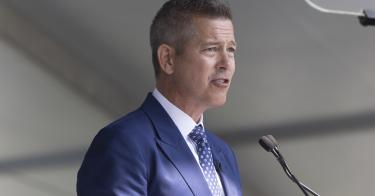A long-overdue revival of our nation’s maritime industry is underway, thanks to President Trump. That’s the good news. Key to this effort is the Maritime Administration, or MARAD—and that’s where the future is less certain.
Even before the June 24th announcement that the superintendent and deputy of the Merchant Marine Academy were stepping down, it was obvious MARAD was in trouble. Their resignations follow years of failed attempts to improve living conditions and training of future merchant mariners.
Those responsible for the delay in action, however, extends further afield to an understaffed and often unresponsive bureaucracy in D.C. According to a recent GAO report, sadly this key organization is short over 116 of an authorized staff of 941 people, of which 43% will be retirement eligible by 2029.
>>> How To Keep the U.S. Maritime Revival Afloat
Moreover, the proposed budget for MARAD hardly instills confidence in a reversal, nor is there much devoted to maritime in the reconciliation bill. The zeroing out of the Cable Security Fleet, for example, makes little sense, given the danger of Russia and China trying to sabotage our economy by cutting undersea cables on which trade and commerce are communicated.
Fortunately, other key programs—like the Tanker Security Program, critical for ensuring fuel moves to our military as needed—seem safer. Many in Congress are aware that the closure of the strategically important Red Hill fuel storage facility in Hawaii has sharpened the vital role of these ships to our military.
But the need for assured shipping in a conflict with China is way beyond what is available today. Recent analysis indicates the nation needs over 1,300 ships involved in international trade to safeguard against Chinese economic blackmail; today we have approximately 188 ships of various classes that can be relied on. Still, budgets and organizational urgency aren’t rising to the threat.
The recently submitted Building SHIPS for America Act is a good step, but given how comprehensive it is, it will take some time before the bill is implemented. And while the President hasn’t hesitated to act with various trade actions and executive orders, without institutional muscle and vigorous leadership, these efforts will stall.
MARAD is understaffed and under-resourced, which definitely contributes to the malaise in America’s maritime sector. But there are structural issues as well.
Back in 2014 Congress mandated a national maritime strategy to reverse the nation’s maritime vulnerabilities. That report, originally due in 2015, wasn’t released until February 2020. This unacceptably long wait resulted in a watered-down final product that hasn’t sparked any real action.
>>> Why the U.S. Should Give Australia Its Old B-2 Fleet
The reason for the delay was partly due to MARAD’s limited influence as a lesser partner within the Department of Transportation—it represents 1.3% of the current budget with .6% of the total department workforce. As such, it has little authority to convene and compel needed interagency consensus on what is a national priority.
In the meantime, another study ordered by Congress in 2023, and completed late in 2024, remains held up at MARAD. That study details the nation’s shipping needs for a wartime economy. Such reports are important and timely given public interest and pending Congressional action.
The energy and attention devoted to MARAD and Kings Point by Sean Duffy, Secretary of Transportation, stands in stark contrast to his predecessor. This is not enough, and the naming of an acting MARAD is only a stopgap.
Sustained energy and vigor with political backing is needed at MARAD, which can only be provided by a Senate-confirmed administrator. The current nominee Steve Carmel has been waiting since May 6 for a hearing.
The window for action is fading fast, making a reversion to past sea blindness likely each day MARAD doesn’t get needed resources guided by energetic leadership.
This piece originally appeared in RealClear Defense




